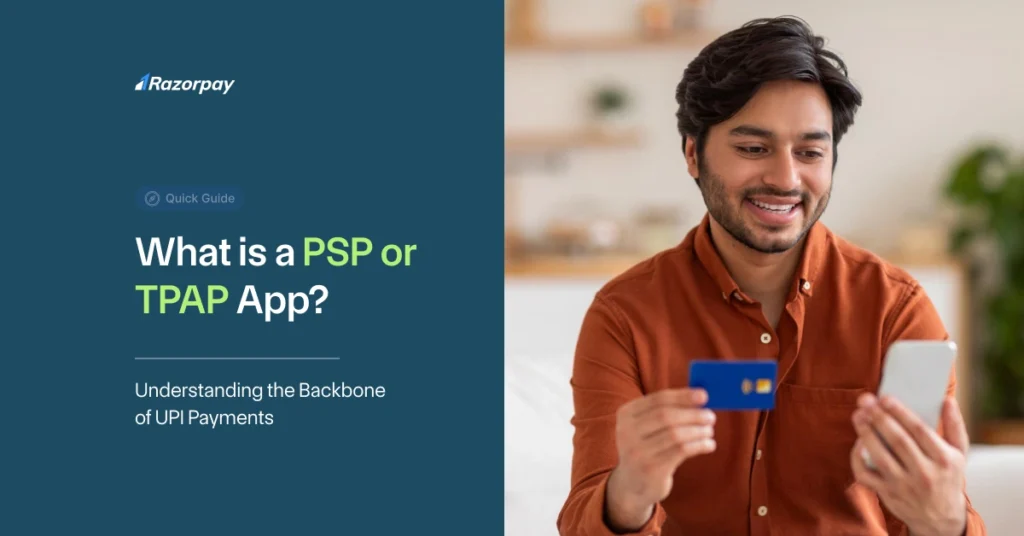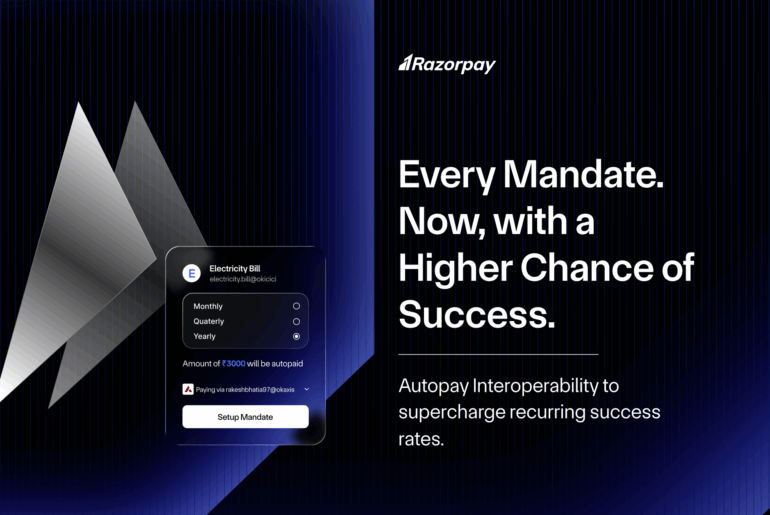When you tap Pay Now on a UPI app, the transaction feels instant and effortless. But behind that simple action is a powerful backend system involving multiple regulated players working together to move money securely. Two of the most critical participants in this system are Payment Service Providers (PSPs) and Third Party Application Providers (TPAPs).
If you’re curious about how UPI works behind the scenes and the different roles and responsibilities of PSPs and TPAPs, you’re in the right place.

What Is a PSP (Payment Service Provider)?
Behind every successful UPI transaction is a Payment Service Provider (PSP) – typically a bank that’s authorised by the National Payments Corporation of India (NPCI) to connect directly with the UPI platform.
These PSP banks are the primary interface between the UPI infrastructure and the Indian banking system. Whether a business is collecting payments via UPI on its website, settling refunds to a customer, or disbursing vendor payouts, the transaction ultimately flows through a PSP. They ensure that funds are routed accurately, securely, and in compliance with regulatory norms – whether the end-user is a consumer or a business entity.
To elaborate a little more, let’s look at the key functions and responsibilities of a PSP i.e. what it is that they actually do –
- Onboarding users and merchants onto UPI: Whether a customer is signing up via the bank’s app or a TPAP’s app, the PSP handles UPI registration, performs KYC, and links funding accounts to UPI IDs.
- Transaction authentication and routing: PSPs validate users during setup, authenticate transactions, and route requests through the UPI system securely and reliably.
- Partnering with TPAPs: PSPs officially onboard TPAPs and are responsible for ensuring their systems are technically and operationally compliant with UPI standards.
- App security and audit oversight: PSPs must ensure that the TPAP’s UPI app is secure, regularly audited, and adheres to guidelines that protect user data and transaction integrity.
- Data localisation and storage: All UPI transaction data must be stored securely in India. The PSP is accountable for this, regardless of whether the data originates from its own app or a TPAP app.
- Bank account linking flexibility: PSPs are required to allow users the option to link any bank account from participating UPI banks – not just accounts with the PSP bank itself.
- Dispute resolution and customer support: PSPs are responsible for addressing UPI-related grievances and resolving disputes – even for transactions that originate from a TPAP app.
So while PSPs handle the backend infrastructure, regulatory compliance, and system-level connectivity, app development and the user-facing experience are typically managed by another key participant in the UPI framework – the Third Party Application Provider (TPAP).
What Is a TPAP (Third Party Application Provider)?
A Third Party Application Provider (TPAP) is a non-bank entity that offers UPI-powered services through a customer-facing app – think of apps like Google Pay, PhonePe, or Cred. While TPAPs aren’t banks themselves, they partner with licensed PSP banks to access the UPI network and enable users to send and receive payments.
In very simple terms, if a PSP is the highway, the TPAP is the vehicle that gets the end-user from point A to point B.
What Do TPAPs Bring to the Table?
Unlike PSPs that handle banking and infrastructure, businesses who become TPAPs focus on delivering the user experience. Their responsibilities include:
- Building and managing the UPI app: TPAPs design the front-end application that users interact with, including onboarding flows, PIN setup, contact syncing, and transaction history.
- Compliance with PSP and NPCI requirements: TPAPs must follow all technical, operational, and security standards set by both the PSP they partner with and the NPCI.
- System security: TPAPs are responsible for ensuring their apps and systems are secure, reliable, and able to function seamlessly within the UPI ecosystem.
- Legal and regulatory adherence: TPAPs must comply with all applicable laws, regulations, and guidelines from statutory and regulatory authorities, including all NPCI circulars related to UPI participation.
- Data storage and localisation: All payment-related data collected by TPAPs – including UPI transaction data – must be stored securely within India.
- Audit cooperation: TPAPs are required to facilitate audits and data access by RBI, NPCI, or any agencies nominated by them, to ensure transparency and compliance.
- Customer grievance redressal: TPAPs must provide users with accessible channels – such as in-app support, email, IVR, or messaging – to raise complaints and resolve disputes related to UPI transactions.
Key Differences Between TPAPs and PSPs
While both PSPs and TPAPs are essential to the UPI ecosystem, their roles, responsibilities, and regulatory obligations differ significantly. PSPs focus on the backend infrastructure and regulatory compliance, while TPAPs specialize in delivering user-facing UPI apps and experiences.
| Aspect | PSP (Payment Service Provider) | TPAP (Third Party Application Provider) |
| Definition | A bank or regulated financial institution directly connected to the UPI platform via NPCI | A third-party app or fintech company that offers UPI services by partnering with a PSP |
| Role in UPI Ecosystem | Enables UPI transactions by handling settlement, compliance, and user authentication | Provides the app interface through which users initiate and complete UPI payments |
| Entity Type | Typically a bank or financial institution regulated by RBI | Fintech company, mobile app, or platform providing UPI functionality |
| NPCI Integration | Directly connected to NPCI and UPI infrastructure | Operates through the PSP’s UPI connection |
| Responsibilities | User onboarding and KYC, transaction routing and settlement, compliance, fraud prevention, dispute resolution | App development, user experience (UI/UX), transaction initiation, customer support |
| Regulatory Oversight | Subject to RBI and NPCI regulations directly; must ensure TPAP compliance | Must comply with applicable regulations via their PSP; also subject to NPCI audits and guidelines |
| Data Storage | Must store all UPI-related data securely and locally within India | Also required to store UPI transaction data within India |
| Grievance Redressal | Provides complaint redressal mechanisms for users and merchants | Offers support channels (in-app, email, etc.) for raising and addressing UPI-related complaints |
| Revenue Model | Earns through transaction processing fees, interchange, and bank partnerships | May monetize through partnerships, premium services, or value-added features in their app |
Understanding the differences between PSPs and TPAPs gives us a clearer picture of their individual roles – but it’s their collaboration that truly powers every UPI transaction.
Let’s break down how these two entities work together behind the scenes to make a payment happen.
How PSPs and TPAPs Collaborate in UPI Transactions
Every UPI payment – whether it’s a customer paying on your app or a business settling vendor dues – is the result of a coordinated effort between the TPAP and the PSP. Together, they handle everything from initiating the request to settling the funds and confirming the transaction.
Here’s a simplified step-by-step breakdown of how that collaboration works:
Step-by-Step: How a UPI Transaction Happens
- User opens the TPAP app
The journey begins on a TPAP app – this is where the user initiates the transaction, whether it’s scanning a QR code, entering a UPI ID, or clicking “Pay.” - TPAP sends the payment request to the PSP
The TPAP packages the transaction details (amount, payee VPA, etc.) and forwards them to the PSP it is integrated with. - PSP authenticates the user and validates the transaction
The PSP performs critical checks – including user authentication (via MPIN or device binding) and ensures there are sufficient funds. - PSP routes the transaction through the NPCI’s UPI switch
Once validated, the PSP passes the request to the NPCI, which acts as the central routing and switching authority. - NPCI forwards the request to the recipient’s bank (another PSP)
The NPCI identifies the recipient bank based on the VPA and sends the debit/credit request accordingly. - Recipient bank confirms the transaction
If everything checks out, the recipient bank credits the funds and sends a success response back through the NPCI. - PSP receives the confirmation and informs the TPAP
The sender’s PSP receives the confirmation and relays it back to the TPAP. - TPAP displays success/failure status to the user
Finally, the user sees a real-time success or failure message in the TPAP app, completing the transaction loop.
How Razorpay TPAP Pro Helps
By now, you’ve got a clear understanding of how UPI works behind the scenes.
If your business is exploring the idea of becoming a TPAP and availing the range of advantages that come with it, the Razorpay TPAP Pro can help. Here’s how –
Razorpay TPAP Pro is a comprehensive solution that helps businesses become TPAPs – without having to build everything from scratch or navigate the regulatory maze alone. We’ve bundled the core infra, compliance, and partner integrations needed to help you go live faster and more securely.
What You Get with TPAP Pro:
- Direct Access to UPI Infrastructure via Razorpay’s partner PSP banks
- Custom-Branded UPI App Support with full control over user experience
- End-to-End Compliance Assistance with NPCI, RBI, and data localization norms
- Robust Security, Risk & Audit Frameworks pre-certified for UPI
- Razorpay’s High-Performance UPI Switch with 99.9%+ uptime and industry-grade latency
- Faster Go-To-Market with ready APIs, SDKs, and expert onboarding support
- Dedicated Account Management for ongoing operations and escalations

Frequently Asked Questions (FAQ)
1. Can a fintech app be both a PSP and a TPAP?
No, only a bank can be a PSP. A fintech app can become a TPAP by partnering with a PSP bank.
2. What role does NPCI play in UPI transactions involving PSP and TPAP?
NPCI operates the UPI infrastructure and sets the rules, certifies participants, and ensures compliance.
3. What are the benefits of using a TPAP for UPI transactions?
TPAPs offer a smooth, branded user experience while integrating seamlessly with UPI rails via PSPs.
4. How do I choose the right PSP or TPAP for my business?
Consider factors like reliability, compliance support, integration options, and time-to-market — or opt for solutions like Razorpay TPAP Pro.



